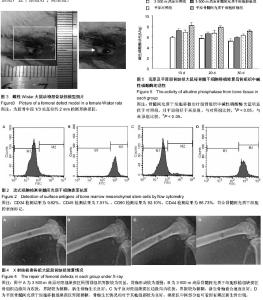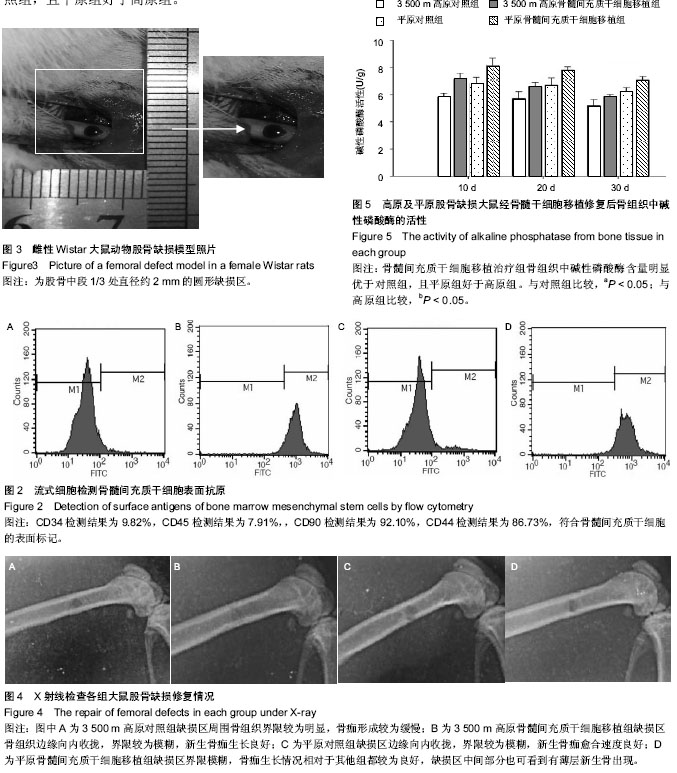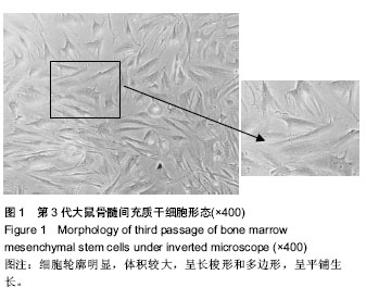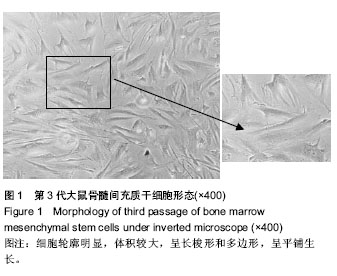Chinese Journal of Tissue Engineering Research ›› 2014, Vol. 18 ›› Issue (14): 2185-2190.doi: 10.3969/j.issn.2095-4344.2014.14.009
Previous Articles Next Articles
Bone marrow mesenchymal stem cell transplantation for repair of rat femoral defects at high altitude
Wang Kun1,2, Fu Xiao-ping1, Yang Zhi-hua2, Zheng Ying2, Gao Zhan2, Gao Cai-yan2, Mai Chao-ping2, Ha Xiao-qin2
- 1College of Veterinary Medicine, Gansu Agricultural University, Lanzhou 730070, Gansu Province, China; 2Department of Clinical Laboratory, Lanzhou General Hospital of Lanzhou Command, Lanzhou 730050, Gansu Province, China
-
Received:2014-02-11Online:2014-04-02Published:2014-04-02 -
Contact:Ha Xia-qin, M.D., Chief physician, Department of Clinical Laboratory, Lanzhou General Hospital of Lanzhou Command, Lanzhou 730050, Gansu Province, China -
About author:Wang Kun, Studying for master’s degree, College of Veterinary Medicine, Gansu Agricultural University, Lanzhou 730070, Gansu Province, China; Department of Clinical Laboratory, Lanzhou General Hospital of Lanzhou Command, Lanzhou 730050, Gansu Province, China -
Supported by:the Military Twelfth Five-Year Plan of Chinese PLA, No. CWS11C229
CLC Number:
Cite this article
Wang Kun1,2, Fu Xiao-ping, Yang Zhi-hua, Zheng Ying, Gao Zhan, Gao Cai-yan, Mai Chao-ping, Ha Xiao-qin. Bone marrow mesenchymal stem cell transplantation for repair of rat femoral defects at high altitude[J]. Chinese Journal of Tissue Engineering Research, 2014, 18(14): 2185-2190.
share this article

2.3 取第3代大鼠骨髓间充质干细胞进行流式细胞表型鉴定 骨髓间充质干细胞表型抗体FITC-CD44检测结果为86.73%,间充质干细胞表型抗体FITC-CD90检测结果为92.10%,间充质干细胞表型抗体FITC-CD34检测结果为9.82%,间充质干细胞表型抗体FITC-CD45检测结果为7.91%(图2)。 2.4 雌性Wistar大鼠动物模型 雌性Wistar大鼠动物股骨缺损模型制作成功,骨缺损形态为股骨中段1/3处直径约2 mm的圆形缺损区(图3)。 2.5 大体观察大鼠腿部活动情况 各组大鼠造模后2 h 麻醉苏醒,右下肢均出现瘫痪症状,拖拽爬行,2 d后右侧腿部瘫痪症状减轻,4 d后可正常行走。进食进水均正常,体质量增长正常,伤口愈合良好,无红肿及渗出,无感染迹象,皮肤缝线自行脱落。 2.6 X射线检测大鼠股骨缺损愈合情况 根据第 30天对照组与治疗组股骨缺损区愈合情况(图4),3 500 m高原对照组缺损区周围骨组织界限较为明显,骨痂形成较为缓慢; 3 500 m高原骨髓间充质干细胞移植组缺损区骨组织边缘向内收拢,界限较为模糊,新生骨痂生长良好;平原对照组缺损区边缘向内收拢,界限较为模糊,新生骨痂愈合速度良好;平原骨髓间充质干细胞移植组缺损区界限模糊,骨痂生长情况相对于其他组都较为良好,缺损区中间部分也可看到有薄层新生骨出现;由此观察得出骨髓间充质干细胞移植治疗组的股骨愈合速度和效果明显优于对照组,且平原组好于高原组。 2.7 骨组织中碱性磷酸酶活性的检测 根据3个时间点的统计数据表明:每个时间点的高原骨髓间充质干细胞移植组的碱性磷酸酶含量,都比高原对照组的高,差异有显著性意义(P < 0.05);而平原骨髓间充质干细胞移植组的碱性磷酸酶含量也都比平原对照组高,且差异有显著性意义 (P < 0.05);高原骨髓间充质干细胞组移植组与平原骨髓间充质干细胞组移植组的碱性磷酸酶含量比差异有显著性意义(P < 0.05);平原对照组与高原对照组的碱性磷酸酶含量差异有显著性意义(P < 0.05),见图5。"

| [1] Long T, Zhu Z, Awad HA, et al. The effect of mesenchymal stem cell sheets on structural allograft healing of critical sized femoral defects in mice. Biomaterials. 2014;35(9):2752-2759. [2] Mao L, Tamura Y, Kawao N, et al. Influence of diabetic state and vitamin D deficiency on bone repair in female mice. Bone. 2013;61C:102-108. [3] 古浩然,高钰琪,罗勇军. 高原心肺复苏研究进展[J].人民军医, 2013,56(6):705-707. [4] Soares LG, Marques AM, Guarda MG, et al. Influence of the λ780nm laser light on the repair of surgical bone defects grafted or not with biphasic synthetic micro-granular hydroxylapatite+Beta-Calcium triphosphate. J Photochem Photobiol B. 2014;131C:16-23. [5] 施咏毅,王根林,杨惠林,等.多孔型丝素蛋白/羟基磷灰石复合脂肪间充质干细胞修复兔股骨骨缺损[J].中国组织工程研究与临床康复,2010,14(8):1341-1344. [6] Gam radt SC,L ieberman JR. Genetic modification of stem cells to enhance bone repair. A nn Biomed Eng. 2004;32(1): 136-147. [7] Lee JS, Hong JM, Moon GJ, et al. A long-term follow-up study of intravenous autologous mesenchymal stem cell transplantation in patients with ischemic stroke. Stem Cells. 2010;28(6):1099-1106. [8] Uccelli A, Moretta L, Pistoia V. Immunoregulatory function of mesenchymal stem cells. Eur J Immunol. 2006;36(10): 2566-2573. [9] 陈佳滨,武成聪,李强,等.转基因技术及骨髓间充质干细胞在骨缺损修复中的应用与展望[J].临床医学工程,2013,20(11): 1457- 1459. [10] Liu L, Yu Q, Lin J, et al, Hypoxia-inducible factor-1α is essential for hypoxia-induced mesenchymal stem cell mobilization into the peripheral blood. Stem Cells Dev. 2011; 20(11):1961-1971. [11] 王鲲,哈小琴. 细胞因子修饰的间充质干细胞[J].中国组织工程研究,2013,17(1):167-172. [12] Kittaka M, Shiba H, Kajiya M, et al. The antimicrobial peptide LL37 promotes bone regeneration in a ratcalvarial bone defect. Peptides. 2013;46:136-142. [13] Takehara Y, Yabuuchi A, Ezoe K, et al. The restorative effects of adipose-derived mesenchymal stem cells on damaged ovarian function.Lab Invest. 2013;93(2):181-193. [14] Joshi M, B Patil P, He Z, et al. Fetal liver-derived mesenchymal stromal cells augment engraftment of transplanted hepatocytes.Cytotherapy. 2012;14(6):657- 669. [15] Can A, Karahusevinoglu S. Concise review: human umbilical cord stroma with regard to the source of fetus-derived stem cells. Stem Cells. 2007;25(11):2886-2895. [16] Yamada M, Tsukimura N, Ikeda T, et al. N-acetyl cysteine as an osteogenesis-enhancing molecule for bone Regeneration. Biomaterials. 2013;34(26):6147-6156. [17] Zhang Y, Cheng N, Miron R, et al. Delivery of PDGF-B and BMP-7 by mesoporous bioglass/silk fibrin scaffolds for the repair of osteoporotic defects. Biomaterials. 2012;33(28): 6698-6708. [18] Zhang Y, Wu C, Luo T, et al. Synthesis and inflammatory response of a novel silk fibroin scaffold containing BMP7 adenovirus for bone regeneration. Bone. 2012;51(4):704-713. [19] Miron RJ, Wei L, Bosshardt DD, et al. Effects of enamel matrix proteins in combination with a bovine-derived natural bone mineral for the repair of bone defects. Clin Oral Investig. 2013 May 8. [20] Baier M, Staudt P, Klein R, et al. Strontium enhances osseointegration of calcium phosphate cement: a histomorphometric pilot study in ovariectomized rats.J Orthop Surg Res. 2013 Jun 7. [21] Wan J, Xia L, Liang W, et al. Transplantation of bone marrow-derived mesenchymal stem cells promotes delayed wound healing in diabetic rats. J Diabetes Res. 2013;2013: 647107. [22] 顾九君,刘兴炎.高原缺氧对骨组织的影响[J].高原医学杂志, 2006,16(1):60-62. [23] Steinbrech DS, Mehrara BJ, Saadeh PB, et al . Hypoxia regulates VEGF expression and cellular proliferation by osteoblasts in vitro. Plast Reconstr Surg.1999;104(3): 738-747. [24] 李生茂,巴军,祝萍,等.不同海拔地区对兔大段骨缺损修复再血管化的影响[J]. 高原医学杂志.2004;14(4):7-10. [25] 张燕搏,王强.间充质干细胞在组织工程中的应用[J].中华实用诊断与治疗杂志.2012;26(3):209-211. [26] Tsai PJ, Wang HS, Shyr YM, et al. Transplantation of insulin-producing cells from umbilical cord mesenchymal stem cells for the treatment of streptozotocin-induced diabetic rats. J Biomed Sci. 2012;19:47. [27] Jendelová P, Herynek V, DeCroos J,et al. Imaging the fate of implanted bone marrow stromal cells labeled with superparamagnetic nanoparticles. Magn Reson Med. 2003; 50(4):767-776. [28] Schneider RK, Anraths J, Kramann R,et al. The role of biomaterials in the direction of mesenchymal stem cell properties and extracellular matrix remodelling in dermal tissue engineering. Biomaterials. 2010;31(31):7948-7959. [29] Neamat A, Gawish A, Gamal-Eldeen AM. beta-Tricalcium phosphate promotes cell proliferation, osteogenesis and bone regeneration in intrabony defects in dogs. Arch Oral Biol.2009; 54(12):1083-1090. [30] De Long WG Jr, Einhorn TA, Koval K, et al. Bone grafts and bone graft substitutes in orthopaedic trauma surgery A critical analysis.J Bone Joint Surg Am. 2007;89(3):649-658. [31] Choudhary S, Alander C, Zhan P,et al. Effect of deletion of the prostaglandin EP2 receptor on the anabolic response to prostaglandin E2 and a selective EP2 receptor agonist. Prostaglandins Other Lipid Mediat. 2008;86(1-4):35-40. [32] Colnot C. Skeletal cell fate decisions within periosteum and bone marrow during bone regeneration. J Bone Miner Res. 2009;24(2):274-282. [33] Otsuru S, Tamai K, Yamazaki T, et al. Bone marrow-derived osteoblast progenitor cells in circulating blood contribute to ectopic bone formation in mice. Biochem Biophys Res Commun. 2007;354(2):453-458. [34] Taguchi K, Ogawa R, Migita M, et al. The role of bone marrow-derived cells in bone fracture repair in a green fluorescent protein chimeric mouse model. Biochem Biophys Res Commun. 2005;331(1):31-36. [35] 李谌,刘丹平.低氧诱导因子1在骨缺损修复过程中的应用[J].中国组织工程研究与临床康复,2008,12(50):9946-9950. [36] Colnot C, Zhang X, Knothe Tate ML. Current insights on the regenerative potential of the periosteum: molecular, cellular, and endogenous engineering approaches. J Orthop Res. 2012;30(12):1869-1878. [37] Evans SF, Chang H, Knothe Tate ML. Elucidating multiscale periosteal mechanobiology: a key to unlocking the smart properties and regenerative capacity of the periosteum? Tissue Eng Part B Rev. 2013;19(2):147-159. [38] Parikka V,Lehenkari P,Saai ML,et al.Estrogen reduces the depth of resorption pits by disturbing the organic bone matrix degradation activity of mature osteoclasts. Endocrinology. 2001;142(12):5371-5378. [39] Tamion F, Richard V, Bonmarchand G, et al. Reduced synthesis of inflammatory cytokines by a free radical scavenger after hemorrhagic shock in rats. Crit Care Med. 200l;28(7):2522-2527. [40] 白孟海,葛宝丰,赵新平,等.高原对去势大鼠骨密度、生物力学和骨组织学的影响及复方红景天对其保护作用[J].西北国防医学杂志,2006,27(6):414-416. |
| [1] | Pu Rui, Chen Ziyang, Yuan Lingyan. Characteristics and effects of exosomes from different cell sources in cardioprotection [J]. Chinese Journal of Tissue Engineering Research, 2021, 25(在线): 1-. |
| [2] | Lin Qingfan, Xie Yixin, Chen Wanqing, Ye Zhenzhong, Chen Youfang. Human placenta-derived mesenchymal stem cell conditioned medium can upregulate BeWo cell viability and zonula occludens expression under hypoxia [J]. Chinese Journal of Tissue Engineering Research, 2021, 25(在线): 4970-4975. |
| [3] | Zhang Xiumei, Zhai Yunkai, Zhao Jie, Zhao Meng. Research hotspots of organoid models in recent 10 years: a search in domestic and foreign databases [J]. Chinese Journal of Tissue Engineering Research, 2021, 25(8): 1249-1255. |
| [4] | Hou Jingying, Yu Menglei, Guo Tianzhu, Long Huibao, Wu Hao. Hypoxia preconditioning promotes bone marrow mesenchymal stem cells survival and vascularization through the activation of HIF-1α/MALAT1/VEGFA pathway [J]. Chinese Journal of Tissue Engineering Research, 2021, 25(7): 985-990. |
| [5] | Shi Yangyang, Qin Yingfei, Wu Fuling, He Xiao, Zhang Xuejing. Pretreatment of placental mesenchymal stem cells to prevent bronchiolitis in mice [J]. Chinese Journal of Tissue Engineering Research, 2021, 25(7): 991-995. |
| [6] | Liang Xueqi, Guo Lijiao, Chen Hejie, Wu Jie, Sun Yaqi, Xing Zhikun, Zou Hailiang, Chen Xueling, Wu Xiangwei. Alveolar echinococcosis protoscolices inhibits the differentiation of bone marrow mesenchymal stem cells into fibroblasts [J]. Chinese Journal of Tissue Engineering Research, 2021, 25(7): 996-1001. |
| [7] | Fan Quanbao, Luo Huina, Wang Bingyun, Chen Shengfeng, Cui Lianxu, Jiang Wenkang, Zhao Mingming, Wang Jingjing, Luo Dongzhang, Chen Zhisheng, Bai Yinshan, Liu Canying, Zhang Hui. Biological characteristics of canine adipose-derived mesenchymal stem cells cultured in hypoxia [J]. Chinese Journal of Tissue Engineering Research, 2021, 25(7): 1002-1007. |
| [8] | Geng Yao, Yin Zhiliang, Li Xingping, Xiao Dongqin, Hou Weiguang. Role of hsa-miRNA-223-3p in regulating osteogenic differentiation of human bone marrow mesenchymal stem cells [J]. Chinese Journal of Tissue Engineering Research, 2021, 25(7): 1008-1013. |
| [9] | Lun Zhigang, Jin Jing, Wang Tianyan, Li Aimin. Effect of peroxiredoxin 6 on proliferation and differentiation of bone marrow mesenchymal stem cells into neural lineage in vitro [J]. Chinese Journal of Tissue Engineering Research, 2021, 25(7): 1014-1018. |
| [10] | Zhu Xuefen, Huang Cheng, Ding Jian, Dai Yongping, Liu Yuanbing, Le Lixiang, Wang Liangliang, Yang Jiandong. Mechanism of bone marrow mesenchymal stem cells differentiation into functional neurons induced by glial cell line derived neurotrophic factor [J]. Chinese Journal of Tissue Engineering Research, 2021, 25(7): 1019-1025. |
| [11] | Duan Liyun, Cao Xiaocang. Human placenta mesenchymal stem cells-derived extracellular vesicles regulate collagen deposition in intestinal mucosa of mice with colitis [J]. Chinese Journal of Tissue Engineering Research, 2021, 25(7): 1026-1031. |
| [12] | Pei Lili, Sun Guicai, Wang Di. Salvianolic acid B inhibits oxidative damage of bone marrow mesenchymal stem cells and promotes differentiation into cardiomyocytes [J]. Chinese Journal of Tissue Engineering Research, 2021, 25(7): 1032-1036. |
| [13] | Guan Qian, Luan Zuo, Ye Dou, Yang Yinxiang, Wang Zhaoyan, Wang Qian, Yao Ruiqin. Morphological changes in human oligodendrocyte progenitor cells during passage [J]. Chinese Journal of Tissue Engineering Research, 2021, 25(7): 1045-1049. |
| [14] | Wang Zhengdong, Huang Na, Chen Jingxian, Zheng Zuobing, Hu Xinyu, Li Mei, Su Xiao, Su Xuesen, Yan Nan. Inhibitory effects of sodium butyrate on microglial activation and expression of inflammatory factors induced by fluorosis [J]. Chinese Journal of Tissue Engineering Research, 2021, 25(7): 1075-1080. |
| [15] | Wang Xianyao, Guan Yalin, Liu Zhongshan. Strategies for improving the therapeutic efficacy of mesenchymal stem cells in the treatment of nonhealing wounds [J]. Chinese Journal of Tissue Engineering Research, 2021, 25(7): 1081-1087. |
| Viewed | ||||||
|
Full text |
|
|||||
|
Abstract |
|
|||||

